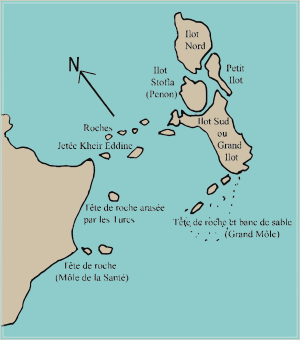Peñón of Algiers facts for kids
The Peñón of Algiers (called Peñón de Argel in Spanish and ḥiṣn aṣ-ṣaḵra in Arabic) was a small island located just off the coast of Algiers. In the 1500s, the Kingdom of Spain built strong defenses on this tiny island. Later, the island was connected to the mainland, helping to create a protective wall for the harbor of Algiers.
Contents
A Look Back: The Peñón's Story
Spain Settles on the Island (1510)
In the year 1510, Spanish forces arrived and settled on the Peñón, a small island north of what is now Algeria. They made a deal with the local ruler, Sālim al-Tūmī. This agreement meant that Spain could stay on the island, and Sālim al-Tūmī had to pay them regular tribute (payments).
To protect their new outpost, the Spanish built strong forts on the Peñón. They also placed a group of 200 soldiers there. As part of the agreement, Sālim al-Tūmī even traveled to Spain to promise his loyalty to King Ferdinand of Aragon.
The Island is Captured (1529)
The Spanish presence on the Peñón did not last forever. In 1529, a famous Ottoman admiral named Hayreddin Barbarossa attacked and captured Algiers. During this event, known as the Capture of Algiers, Barbarossa also took control of the Peñón.
After capturing the island, Barbarossa ordered the Spanish forts to be torn down. This action ended Spain's control over the Peñón and its presence in the area.
See also
 In Spanish: Peñón de Argel para niños
In Spanish: Peñón de Argel para niños



